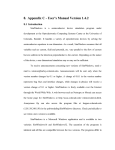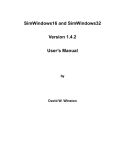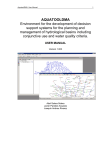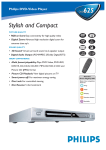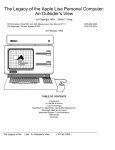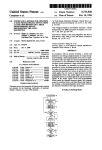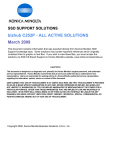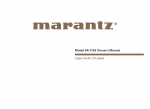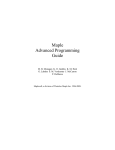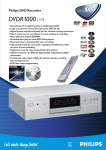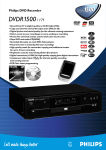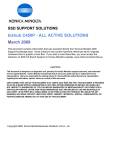Download Latest information
Transcript
SimWindows16 v. 1.4.2: updated on Apr 29 1996 at 13:53:00 SimWindows32 v. 1.4.2: updated on Apr 29 1996 at 15:49:27 (Note if this file appears to wide for your screen, go to File|Print Setup and choose portrait.) State Files are compatible with version 1.4.0 and 1.4.1 This version fixes six bugs found with version 1.4.1. 1. Optical Generation Dialog Box - After inputting a single wavelength and intensity, if a new intensity is entered, the dialog box would not use the new intensity. That has been corrected. 2. Thermal Conductivity - The material parameters file had an incorrect model for the AlGaAs thermal conductivity. 3. Optical Generation Spectrum and Hot Electrons - There was a bug that incorrectly calculated the amount of energy supplied to electrons from an input optical spectrum. It worked correctly for a single wavelength. 4. State Window - Under special conditions, SimWindows would crash when generating a device. That has been solved. 5. Doping Statement - If a doping statements are not in the device file, SimWindows would crash. SimWindows now defaults to intrinsic material if there are no doping statements. 6. Data Column Headers - Under special conditions, when saving data from a plot to a file the column headers would not be written. That has been solved. SimWindows16 v. 1.4.1: updated on Mar 19 1996 at 15:15:45 SimWindows32 v. 1.4.1: updated on Mar 19 1996 at 15:13:15 State Files are compatible with version 1.4.0 This version fixes three bugs found with version 1.4.0. 1. Tunneling Energy Flow: A bug was found for the energy flux resulting from tunneling using Boltzmann statistics. It produced strange discontinuities in the temperature. 2. AlGaAs Electron DOS Mass: There was an incorrect model used in the material parameters file. It was correct for x<0.45 but incorrect for x>0.45. 3. Silicon Absorption: There was an incorrect model used in the material parameters file for the Silicon absorption. It was incorrect for higher photon energies. SimWindows16 v. 1.4.0: updated on Mar 10 1996 at 19:14:32 SimWindows32 v. 1.4.0: updated on Mar 10 1996 at 19:12:07 State Files are incompatible with version 1.3.1. 1. Spectrum Multiplier - A number can be specified in the optical input dialog box that will be multiplied to the input input spectrum. This can be used to increase or decrease a spectrum without modifying the spectrum file. 2. Hot Electrons - Hot electrons are now incorporated in the thermal models dialog box. SimWindows assumes that the hole and lattice temperatures are constant and the electron temperature can vary. 3. Tunneling Current - tunneling through thin barriers between different materials has be incorporated. 4. Optical Generation cross term - There was an incorrect equation for the optical generation rate when using incident reflections. That has been fixed. 5. QW Intrinsic concentration - A new equation for the intrinsic carrier concentration of a quantum well has been incorporated. It modifies the value slightly when fermi-dirac statistics are applicable. 6. QW Energy level - There was a bug that modified the quantum well energy levels slightly. That has been fixed. 7. Temperature Dependent Ref Index - The default model for the index of refraction for AlGaAs has been made temperature dependent (based on the temperature dependence of the band gap of the material). 8. Modified Laser Parameters - Laser parameters have been modified. The cavity area has replaced the width and height. The cavity length must now be specified. The length is no longer the distance between the mirrors. SimWindows16 v. 1.3.1: updated on Dec 16 1995 at 16:51:53 SimWindows32 v. 1.3.1: updated on Dec 16 1995 at 16:49:25 State Files are compatible with version 1.3.0. 1. Optical Input Dialog Bugs: Several bugs were found in the optical input dialog box which have been corrected. The bugs are: a: Off button - After turning the optical input on, the off button did not work. It would show off, but the optical input was still on. b. Interface Reflection Button - After checking on the interface reflections, checking off the interface reflections had no affect. c. Single Wavelength Inputs - If a state file was loaded with a spectrum present (for example the pmqwn.sta file included with SimWindows) and you tried to turn off the optical input, the Energy/Wavelength and Intensity edit boxes would incorrectly request a value. SimWindows16 v. 1.3.0: updated on Nov 21 1995 at 21:21:08 SimWindows32 v. 1.3.0: updated on Nov 21 1995 at 21:18:41 State Files are incompatible with older versions 1. Fermi-Dirac Statistics: There is the option of choosing either Boltzmann or Fermi-Dirac statistics. 2. Incomplete Ionization: The dopant level and the degeneracy factor can be specified in the device file. The user can select to have the dopant completely ionized or only partially ionized. 3. Collision Factors: The Energy dependence on the momentum relaxation time (the famous 1/2, -1/2, 3/2 etc) can be specified in the material parameters file. These coefficients end up by appearing in the non-isothermal drift-diffusion equations for both current and energy flux. 4. Doping and Temperature Dependent Mobility: The mobility is now dependent on the doping concentration as well as the carrier and lattice temperature. A built in model is provided and is applied to Si. The same model can be applied to other materials if desired. 5. Temperature Dependent Electron Affinity: The electron affinity is now temperature dependent. By default, the electron affinity increases by half the amount that the band gap decreases with temperature. If effect, the band gap narrowing is split evenly by the conduction and valence bands. 6. Wider Temperature Ranges: The environment temperature will accept values between 50 and 5,000K. However, numerical problems may appear depending on the device and temperature. 7. Gridpoints on Plots: The actual location of grid points can be viewed on plots by choosing the Plot|Show Nodes menu option. 8. Thermionic emission energy flow bug: There was a bug that affected the energy flow associated with thermionic emission current. That has been corrected. 9. Creating a device with error bug: If a device had been generated and a second device that had an error in the device file was generated, the error message would not appear and SimWindows would crash. That has been corrected. SimWindows16 v. 1.2.0: updated on Sep 17 1995 at 21:18:42 SimWindows32 v. 1.2.0: updated on Sep 17 1995 at 21:16:45 State Files are incompatible with older versions 1. General Functions: General algebraic functions (including exponential and trigonometric) can be used in the material parameters file and the device file. 2. Built-in models: A few material parameters have built-in models that can be used if desired. 3. Material Parameter Overrides: Material Parameters can be overriden in the device file. 4. Preferences: There are more options available under Environment|Preferences that can be changed and saved in a simwin.ini file. Simulation Parameters have been moved to the preferences. 5. Simulation Undo: When enabled, it is possible to undo a simulation and return to the state just prior to the previous simulation. 6. Trap Convergence Errors: If a numerical problem results during simulations, SimWindows will stop and allow you to reset the device or undo the simulation (This is not 100% bullet proof, but it is far better than when SimWindows would just crash). 7. Interface Reflections: For external optical generation and DBR lasers, interface reflections have been added. Reflection/Transmission vs. wavelength plots are now possible. 8. DBR Laser Mode Search: Given an initial guess for the lasing wavelength, SimWindows can compute the optical field and actual lasing wavelength for a DBR laser and track it as a function of temperature. 9. Hot electrons: Code for solving the hot electron problem has been added. However, it is completely disabled until we are satisfied that it is working correctly. 10. New Printer Driver: There is a new printing routine for plots only. I hope this will fix problems that user's had experiences. 11. Temperature Dependent Thermal Conductivity Bug Fix: There was a bug when computing the temperature dependence on the thermal conductivity that reduced that conductivity too much for a given temperature. 12. Frozen Plot Write Data Bug Fix: There was a bug when saving data of a frozen plot. It would output the actual data from the device rather than what was actually plotted. 13. State File Checking: If you try to load a state file from a previous version of SimWindows, an error message results. 14. Line Number Control: The status bar now displays the line number of the cursor when editting files. 15. Multiple Plots from when Plotting Selected: When choosing to plot selected parameters, multiple plots are generated if multiple parameters are selected. SimWindows16 v. 1.1.1: updated on Apr 16 1995 at 21:56:46 SimWindows32 v. 1.1.1: updated on Apr 16 1995 at 21:53:58 State Files are incompatible with older versions Version 1.1.1 fixes one important bug, and uses the latest version of the O'Setup Installer. There is plenty of code work in preparation for hot carriers, but those changes are user transparent. 1. Thermal Equations Bug Fix - The thermal equations contained a bug that affected the thermoelectric heat, but NOT joule heating. That problem has been fixed. 2. New Installer - The latest version of the O'Setup Installer is now being used. SimWindows16 v. 1.1.0: updated on Mar 22 1995 at 12:21:33 SimWindows32 v. 1.1.0: updated on Mar 22 1995 at 12:19:53 State Files are incompatible with older versions Version 1.1.0 of SimWindows is a relatively large evolutionary step from version 1.0.2 (the last released version). There have been many changes made to the code as well as features added. I hope that this has not introduced a large number of new bugs, but there will probably be a couple of maintanence releases in the next couple of weeks. Here is a list of the new features: 1. Printing - The contents of device, state, and plot windows can be printed. There is a large potential for bugs in this area (largely resulting from the different kinds of printers) and I would like to know about them. 2. Macros - You can now perform a series of calculations (i.e. I-V curves) and examine the results. There is also a large potential for bugs in this area. The only macro available is the voltage macro where the applied contact potential is changed. Different kinds of macros (i.e. temperature, input optical frequency, input optical intensity) will appear in later versions. 3. Band gap and thermal conductivity - These two parameters are now temperature dependent. The material.prm file has been expanded to allow values to be varied which controls the dependence of these parameters on temperature. 4. Lateral Heat flow - My model for lateral heat flow now has a user interface. This models assumes that the device is cylindrical (with a specified radius) and the environment temperature surrounds the device in a cylindrical geometry. Heat flow is calculated in the direction along the device as well as laterally out to the environment. This option can of course be turned off. 5. Contacts and Surfaces - The contacts dialog box has been split into contacts and surfaces. This will allow the future feature of having contacts that are not necessarily at the same location as the device surface. 6. Freeze Plot - Plots can be "frozen" and "melted". When a plot is frozen, the data is not updated when the state of the device changes. This allows data for two different device states to be compared. When the plot is melted the data is updated to reflect the current device state. 7. Plot Parameters - Any positionally dependent variable can now be plotted. 8. Write Parameters - Any combination of parameters can be now be written to a disk file. 9. Operation - There are a number of subtle changes in the operation of SimWindows. For instance if the environment temperature is changed, the state of the device is no longer reset to the initial solution. It just needs to be resimulated in the present state. 10. User Manual - Included on the distribution disks is a postscript file of the present User Manual. It is not complete yet, but the finished sections are included. 11. Windows NT - SimWindows will now run on Windows NT. SimWindows16 v. 1.0.2: updated on Feb 1 1995 at 18:58:12 SimWindows32 v. 1.0.2: updated on Feb 1 1995 at 18:55:20 State Files are incompatible with older versions 1. Bug fixes: Version 1.0.2 is basically to fix a couple of bugs. Note that version 1.0.1 was never released because I discovered a virus on my system at about the time I was ready to release version 1.0.1. The bugs that were fixed over v. 1.0 are: a. New parameters entered in the laser dialog box are used in subsequent calculations. b. SimWindows works correctly on systems where the background window color is set to a non-white color. c. SimWindows tended to crash if more than 4 plots were opened and subsequent iterations were performed. This has been corrected. SimWindows16 v. 1.0.1: Never Released SimWindows32 v. 1.0.1: Never Released SimWindows16 version 1.0.0: updated on Jan 10 1995 at 17:22:42 SimWindows32 version 1.0.0: updated on Jan 10 1995 at 17:19:46 1. User interface: The user interface has been completly redesigned. It is much more sophisticated and robust. Also this is the first release of SimWindows32 which is a 32-bit version that runs about twice as fast as SimWindows16. The new user interface has a price. The .exe files are now quite larger. Simwin16.exe has increased by ~300k to ~ 860k. Simwin32.exe is ~650k. However the result is well worth it. The main features that have been added are: a: Multiple Windows: SimWindows is a multiple document interface (MDI) application. This means that more than one window can be created at one time. So it is possible to see more than one plot and also edit more than one device file. You can also iconify windows as well as arrange and tile them. b. Tool bar. A tool bar is present which allows the most frequent functions to be executed easily. c. Flyby hints. As you move the pointer over tools in the tool bar or over menu items, hints for that particular item are displayed at the bottom of the screen. d. Input validation. When you input values into dialog boxes they are checked to see if they fall within a certain range. If they do not then a message is displayed. c. Trace Window. It is now possible to get information directly off of plots. Select the plot window and then choose "Show trace window" from the Plot menu. A trace window will be display. As you move the pointer across the plot the corresponding data will be displayed in the window. d. Improved Scale dialog box. An operation for the y data as been added to the scale dialog box. This was added because of the problem of plotting both positive and negative data on a log plot. For example the total recombination rate can be both positive and negative, but it is also desireable to view it on a log plot. Therefore if any data is less than or equal to zero then it not be drawn on the plot. To view this data select the -y option. This will then show the negative of the data. An abs(y) option is also available to view the absolute value of the data.






